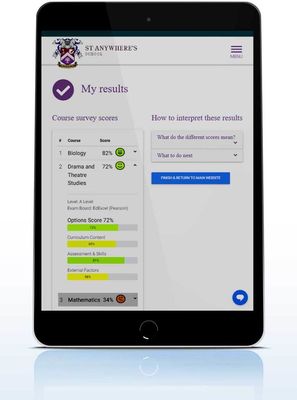Benefits of the Options Service
Options benefits Schools and Colleges
Options provides impartial, accurate information about the courses offered, packaged in an interactive web-tool to help students make better choices.
Neither Sixth Form teachers nor College lecturers need research to tell them that students are best placed to succeed if they are interested in the contents of the courses they choose to study. Options is a tool to help students consider objectively the contents of courses they are considering choosing.Find out how it works
Options aims to help schools & colleges:
- improve successful course choices by students,
- improve course retention and attainment,
- improve the data available to teachers, allowing better preparation of course delivery by taking into account aspects of courses students have more or less confidence in;
- improve students’ experience of the school's/college's admissions process through provision of a student friendly course choice tool to help them navigate those difficult decisions.
Options Benefits Students
Having anything from over 20 to close to 100 courses to choose from is not easy. The Options tool helps students to objectively assess what is best for them.
Students often choose post-16 courses in subjects they did well in at GCSE, hoping they will do as well once more. Those who achieved worse that they had hoped often choose subjects they no experience of, in the hope of finding a subject they’ll do well in. At other times courses are picked because of their perceived value in terms of progression to university or employment.
Although most students want to take courses they’ll find interesting, many other factors come into play that complicate their decision-making, such as:
- A-Levels & BTECs may be very different to GCSE;
- Interest in a subject is shaped by real experience of specific curriculum content not generic ideas about courses;
- Choices can be influenced by fashions, peers & family (who may know less about the courses than the student).
How can we address these problems? Students need to know what they can expect from a course before they begin.
Forewarned is forearmed
Students complete short surveys about courses they are considering. They’re asked to express how much they might enjoy core aspects of each course and how they would be assessed. The process reveals to them how much they do or don't know about the courses and prompts them to reflect more carefully about their choices. We also include some other questions to help the process of deliberation.
On completion, the student's course scores are presented in simple rank order. The student can quickly and easily see which courses are more appealing to them and what kind of motivation is influencing their perspectives on the course. Armed with this information, students are in a much stronger position to make informed, considered and successful course choices.

Options Benefits Teachers and Managers
Options provides teachers/lecturers with course profiles.
Every teacher/lecturer knows that much of the success of students depends on their real engagement with course materials and topics. By using the Options tool in the recruitment process, this success-factor is placed right in the foreground.
Once it is clear which students have been admitted to each course, those students' Options data are combined to produce class profiles that clearly present this specific cohort's strengths of interest in different parts of the course. This information can be used to help plan schemes of work and encourage students in relation to areas of the course they are anxious about. They can also be used to help agree learning targets.
Options data also allows teachers to evaluate their course delivery against initial levels of students’ subject interest. Combined with other data on students’ motivations for choosing the course, the data can help teachers reflect on areas of teaching & course planning that could be improved to encourage greater student engagement.

